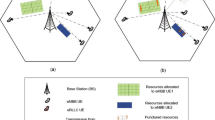Abstract
Call admission control (CAC) schemes play a critical role in providing quality-of-service (QoS) guarantees for various classes of traffic with diverse QoS requirements in IEEE 802.16e networks. The dynamic CAC and bandwidth reservation scheme is one of the current schemes that simultaneously provides efficient utilization of network resources and guarantees QoS for admitted connections. However, its admission criteria starved high and low service classes due to its linear adaptation policy to accommodate more users into the network under moderate-to-heavy traffic load conditions. Its adaptive threshold for handoff connections is adjusted based on the arrival of new and handoff connections, that results in a waste of resources when the new and handoff connection arrival rate occurs frequently. In this paper, a new CAC scheme for Mobile WiMAX networks is proposed to prevent starvation of service classes and enhance the efficient utilization of network resources. The scheme determines a new admission criteria based on a scheduling service class. In the admission criteria, bandwidth degradation policy is used to admit more users when there is no available bandwidth to admit a more users. The adaptive threshold has been introduced dynamically to adjust the quantity of reserved bandwidth for handoff connections based on the traffic intensity of handoff requests. In addition, an analytical model for the proposed scheme is also developed. Extensive simulation experiments have been conducted to evaluate the performance of our proposed approach. The simulation results illustrate that the proposed scheme significantly improves the network efficiency compared to other schemes in terms of accepting more connections into the network and assuring QoS for all service classes. The numerical results have shown similar performance to the simulation results.









Similar content being viewed by others
References
IEEE 802.16 Working Group. (2005). IEEE standard for local and metropolitan area networks. Part 16: Air interface for fixed broadband wireless access systems. Amendment 2: Physical and medium access control layer for combined fixed and mobile operation in licensed bands. IEEE Std 802.
Borin, J. F., & da Fonseca, N. L. S. (2008). Simulator for WiMAX networks. Simulation Modelling Practice and Theory, 16(7), 817–833.
Othman, Jalel Ben, Mokdad, Lynda, & Ghazal, Sahar. (2014). Performance analysis of WiMAX networks AC. Wireless Personal Communications, 74(1), 133–146.
Naghshbandi, D., Subramaniam, S., & Moghadam, S. R. (2013). An event-driven simulation for highest urgency first (HUF): A latency and modulation aware bandwidth allocation algorithm for WiMAX base stations. Wireless Personal Communications, 69(1), 39–52.
Saidu, I., Subramaniam, S., Jaafar, A., & Zukarnain, Z. A. (2015). An efficient battery lifetime aware power saving (EBLAPS) mechanism in IEEE 802.16 e networks, wireless personal communications (pp. 1–21). Berlin: Springer.
Lu, J., & Ma, M. (2011). Cross-layer QoS support framework and holistic opportunistic scheduling for QoS in single carrier WiMAX system. Journal of Network and Computer Applications, 34(2), 765–773.
Ali, Mohammed A., Borhanuddin, Mohd A., Nor, Kamariah N., & Hafizal, Mohamad. (2013). Fair uplink bandwidth allocation and latency guarantee for mobile WiMAX using fuzzy adaptive deficit round robin. Journal of Network and Computer Applications, 39, 17–25.
Yang, S.-F., Wu, J.-S., & Hwang, B.-J. (2013). Performance evaluation of priority based adaptive multiguard channel call admission control for multiclass services in mobile networks. International Journal of Communication Systems, 26(5), 597–609.
Wang, H., Li, W. & Agrawal, D.P. (2005). Dynamic admission control and QoS for 802.16 wireless MAN. In Wireless Telecommunications Symposium, 2005 (pp. 60–66) IEEE.
Hou, F., Ho, P.-H. & Shen, X. (2006). WLC17-1: Performance analysis of a reservation based connection admission scheme in 802.16 networks. In Global Telecommunications Conference, 2006. GLOBECOM’06. IEEE (pp. 1–5), IEEE.
Wongthavarawat, K., & Ganz, A. (2003). Packet scheduling for QoS support in IEEE 802.16 broadband wireless access systems. International Journal of Communication Systems, 16(1), 81–96.
Jiang, C-H. & Tsai, T-C. (2006). Token bucket based CAC and packet scheduling for IEEE 802.16 broadband wireless access networks. In Consumer Communications and Networking Conference, 2006. CCNC 2006. 3rd IEEE (Vol. 1, pp. 183–187), IEEE.
Ge, Y. & Kuo, G-S. (2006). An efficient admission control scheme for adaptive multimedia services in IEEE 802.16 e networks. In Vehicular Technology Conference, 2006. VTC-2006 Fall. 2006 IEEE 64th (pp. 1–5), IEEE.
Wang, L., Liu, F., Ji, Y., & Ruangchaijatupon, N. (2007). Admission control for non-preprovisioned service flow in wireless metropolitan area networks. In Universal Multiservice Networks, 2007. ECUMN’07. Fourth European Conference on (pp. 243–249), IEEE.
Chaudhry, S.B. & Guha, R.K. (2007). Adaptive connection admission control and packet scheduling for QoS provisioning in mobile WiMAX. In Signal Processing and Communications, 2007. ICSPC. IEEE International Conference on, 2007 (pp. 1355–1358), IEEE.
Wang, C., Yan, W.-J., & Lo, H.-K. (2012). Dynamic admission control and bandwidth reservation for IEEE 802.16 e mobile WiMAX networks. EURASIP Journal on Wireless Communications and Networking, 1, 1–20.
WiMAX, Forum. (2006). Mobile WiMAX—Part I: A technical overview and performance evaluation (pp. 9–24). Mobile, WiMAX Forum: WiMAX-Part.
Antonopoulos, A., Skianis, C. & Verikoukis, C. (2010) Traffic-aware connection admission control scheme for broadband mobile systems. In Global Telecommunications Conference (GLOBECOM 2010), 2010 IEEE (pp. 1–5), IEEE.
Author information
Authors and Affiliations
Corresponding author
Rights and permissions
About this article
Cite this article
Saidu, I., Subramaniam, S., Jaafar, A. et al. A QoS-Aware CAC with Bandwidth Reservation and Degradation Scheme in IEEE 802.16e Networks. Wireless Pers Commun 82, 2673–2693 (2015). https://doi.org/10.1007/s11277-015-2372-8
Published:
Issue Date:
DOI: https://doi.org/10.1007/s11277-015-2372-8




